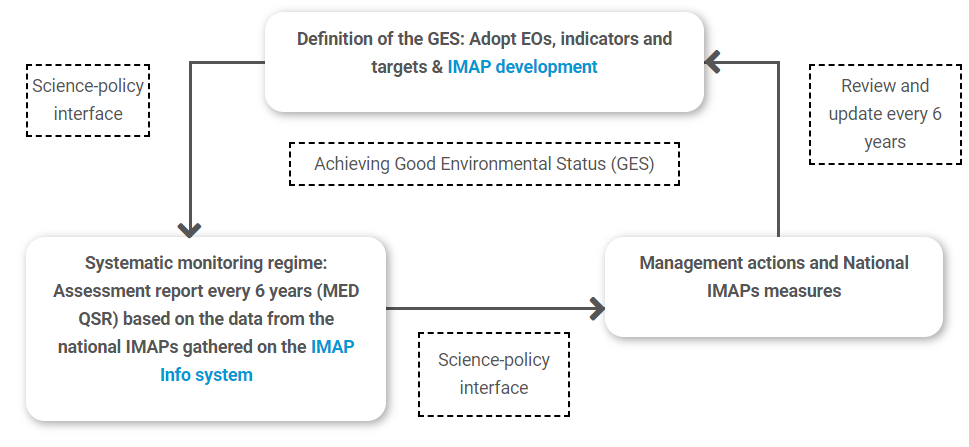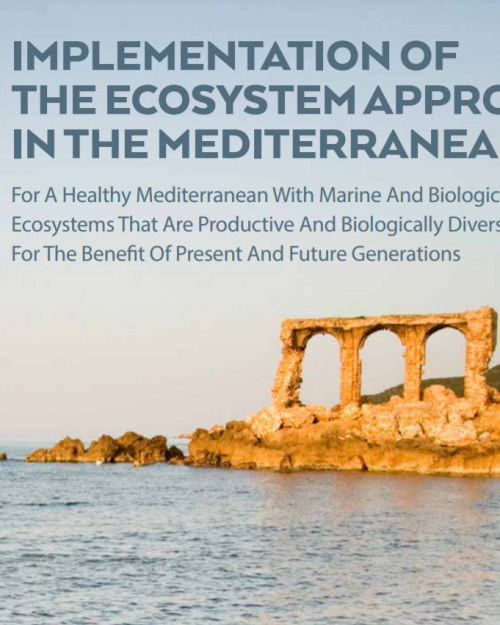Background
The Barcelona Convention describe the ecosystem approach, as defined by the Convention on Biological Diversity (CBD), “a strategy for the integrated management of land, water and living resources that promotes conservation and sustainable use in an equitable way". This approach goes beyond examining single issues, species, or ecosystem functions in isolation. Instead, it recognizes ecological systems for what they are: rich mixes of elements that interact with each other continuously. The Ecosystem Approach (EcAp) recognizes that humans, with their cultural diversity, are an integral component of the ecosystems. Indeed, it aims to improve the sustainability of human activities’ management for the protection of the marine environment.
At the COP 15 of the Barcelona Convention, held in Almeria, Spain in January 2008, the Contracting Parties agreed to progressively apply the EcAp to the management of human activities that may affect the Mediterranean marine and coastal environment for the promotion of sustainable development. They agreed on a common vision for the Mediterranean: “A healthy Mediterranean with marine and coastal ecosystems that are productive and biologically diverse for the benefit of present and future generations”. With the adoption of the EcAp strategy, and its seven-step roadmap, Contracting Parties have committed to implement EcAp in the Mediterranean with the ultimate objective of achieving the Good Environmental Status (GES) of the Mediterranean Sea and its coast.
The EcAp process and its implementation Roadmap
Definition of a common vision: “A healthy Mediterranean with marine and coastal ecosystems that are productive and biologically diverse for the benefit of present and future generations”
Definition of the Strategic Goals
Initial integrated assessment: Gather Information, Collate & Map
interface
Definition of the GES: Adopt EOs, indicators and targets & IMAP development
Systematic monitoring regime: Assessment report every 6 years (MED QSR) based on the data from the national IMAPs gathered on the IMAP Info system
Management actions and National IMAPs measures
The GES has been defined through eleven Ecological Objectives (EO) and corresponding operational objectives which their achievement is being monitored with the help of a set of common indicators for the Mediterranean (Decisions IG.20/4 and IG. 21/3).
- EO1 Biological diversity: Biological diversity is maintained or enhanced. The quality and occurrence of coastal and marine habitats and the distribution and abundance of coastal and marine species are in line with prevailing physiographic, hydrographic, geographic and climatic conditions;
- EO2 Non-indigenous species: Non-indigenous species introduced by human activities are at levels that do not adversely alter the ecosystem;
- EO3 Harvest of Commercially exploited fish and shellfish: Populations of selected commercially exploited fish and shellfish are within biologically safe limits, exhibiting a population age and size distribution that is indicative of a healthy stock;
- EO4 Marine food webs: Alterations to components of marine food webs caused by resource extraction or human-induced environmental changes do not have long-term adverse effects on food web dynamics and related viability;
- EO5 Eutrophication: Human-induced eutrophication is prevented, especially adverse effects thereof, such as losses in biodiversity, ecosystem degradation, harmful algal blooms and oxygen deficiency in bottom waters;
- EO6 Sea floor integrity: Sea-floor integrity is maintained, especially in priority benthic habitats;
- EO7 Hydrography: Alteration of hydrographic conditions does not adversely affect coastal and marine ecosystems;
- EO8 Coastal ecosystems and landscapes: The natural dynamics of coastal areas are maintained, and coastal ecosystems and landscapes are preserved;
- EO9 Contaminants: Contaminants cause no significant impact on coastal and marine ecosystems and human health;
- EO10 Marine litter: Marine and coastal litter do not adversely affect coastal and marine environment; and
- EO11 Energy including Underwater noise: Noise from human activities cause no significant impact on marine and coastal ecosystems.
SPA/RAC’s work focuses in particular on four EOs, which are EO1, EO2, EO3, EO4 and EO6.
At their 19th Ordinary Meeting (COP 19, Athens, Greece, 9-12 February 2016), the Contracting Parties to the Barcelona Convention adopted an Integrated Monitoring and Assessment Programme of the Mediterranean Sea and Coast and Related Assessment Criteria (IMAP) for the region (Decision IG.22/7). It describes the strategy, themes, and products that the Mediterranean countries are aiming to deliver in order to assess the status of the Mediterranean Sea and coast, as a basis for further and/or strengthened measures, management plans and programmes. The IMAP must be reviewed every six-year, with the first assessment based on the IMAP was delivered in 2017 and called the 2017 Mediterranean Quality Status report (2017 MED QSR).
Successive projects funded by the European Union (EU) and the Global Environment Facility (GEF) have supported the implementation of EcAp in the Mediterranean.
The implementation of the EU Marine Strategy Framework Directive (MSFD) by the EU countries in the Mediterranean also presents crucial opportunities for the application of EcAp in the region, ensuring that the MSFD and EcAp mutually strengthen and build on each other, without duplication of activities and obligations.
The EcAp governance
The established governance structure of the EcAp is as follows:
The EcAp Coordination Group (EcAp CG), consisting of MAP focal points, the Coordinating Unit, the MAP components and MAP partners to oversee the implementation of the ecosystem approach, identifying progress gaps in the implementation of the Roadmap and find feasible solutions for the advancement of the EcAp agenda.
Three Correspondence Groups are formed in the process of the EcAp application in the Mediterranean in order to support the EcAp CG:
- The Correspondence Group on GES and Targets (CORGEST), composed of national experts designated by the Contracting Parties, and coordinated by the Barcelona Convention/UNEP-MAP CU and its components, works to ensure efficient coverage and in-depth discussions and analysis of all EOs in 3 clusters: i) Biodiversity and Fisheries; ii) Coast and Hydrography; and iii) Pollution and marine litter.
- The Correspondence Group on Monitoring (CORMON), composed of national experts designated by the Contracting Parties, and coordinated by Barcelona Convention/UNEP-MAP CU and its components, works to ensure efficient coverage and in-depth discussions and analysis regarding integrated monitoring and assessment of the 3 clusters: i) Biodiversity and Fisheries; ii) Coast and Hydrography; and iii) Pollution and marine litter, with reference to the outcomes of the CORGEST.
- The Correspondence Group on Economic and Social Analysis (CORESA) is composed of national experts designated by the Contracting Parties to the Barcelona Convention and invited experts and coordinated by the Barcelona Convention/UNEP-MAP CU and Plan Bleu/RAC. It develops socio economic analysis of marine ecosystems uses, focusing on priority sectors such as fisheries, aquaculture, maritime transport, recreational activities, and oil industry and offshore.
EcAp governance
-
- COP of the Barcelona Convention
- Components’ FPs meetings
- CORGEST
(Good Environmental Status and Targets)
Subgroups:
Biodiversity & Fisheries
Coast & Hydrography
ollution & Litter - CORMON
(Integrated monitoring and assessment)
Subgroups:
Biodiversity & Fisheries
Coast & Hydrography
Pollution & Litter - CORESA
(socio economic analysis of marine ecosystems uses)
- COP of the Barcelona Convention
Media
This short-animated film presents the Ecosystem Approach in the Mediterranean (also available in French).




